(10 am. – promoted by ek hornbeck)
Accordingly to an article entitled, “More Women Are bringing Home the Bacon…, ” heralding women’s gains in pay equity, a recent Pew study revealed that an impressive number of married breadwinner moms reflects society’s increasing opportunities for women, while the median income for the growing population of single mother households is $23,000 — just 28 percent of the income of one in which the female breadwinner is married, and less than half the median household income in America.
So What Else Is New?
The wage gap between women’s and men’s individual wages is the most standard indicator used to define women’s march toward equality. In recent studies of the gender wage gap, women make between 76 to 78 cents for every dollar made by men and most literature is optimistic that the gap will disappear or even reverse in the near future. The gender wealth gap, however, another measure of gender inequality which measures the total wealth or net worth a woman has accumulated over time, shows that women have, on average, only 6% to 36% of the wealth owned by men and that the gap is growing.
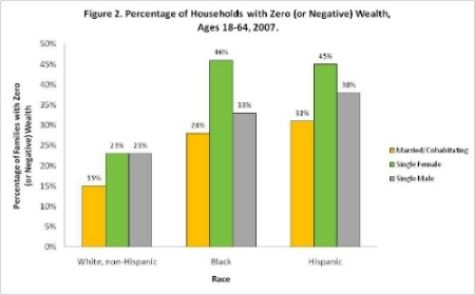
source:http://www.cunapfi.org/download/198_Women_of_Color_Wealth_Future_Spring_2010.pdf
The stark difference between these two measures suggests two things about statistics:1) statistics on the same subject can fluctuation wildly depending on what is being measured and the methodology used and 2) One of the main functions of statistics is not to measure the reality, but as a propaganda tool to reinforce the ideology of the dominant culture.
The problem with using the wage gap . As a measure of inequality, the gender wage gap only measures an individual’s income growth in the market place and does not take into account either the worth of women’s unpaid social labor in the home(outside the marketplace) or how this unpaid labor structurally effects women’s position in the market place over time.
Because of its narrow parameter, much of the analysis of what the wage gap means in terms of the overall inequality of men versus women is merely a guess that allows for a lot of unverifiable interpretations. For example, the recent Pew study echoes a demographic study that hit the New York Times a couple of years ago that showed a narrowing of the wage gap, suggesting women’s wages were even surpassing men’s in some cases, especially in major cities.
The cause of women’s increased equality, the researcher suggested, was due to increases in women’s higher educational status and increased “feminist consciousness.” In fact, a closer analysis showed that the close in the wage gap was due to the outsourcing of well paying union manufacturing jobs which had been held by men due to a sex segregated workforce. By focusing on city populations where people of color form a larger part of the database, the lower gap also reflected the fact that the wage gap is generally lower between women and men of color since men of color generally make significantly less than white men due to racism.
The important thing that we have to understand about the Wage Gap is that, if we review the literature, it is used primarily as a political propaganda tool emphasizing upward mobility in a capitalist society by improving the individual upward mobility of women through education. By limiting the parameters to women’s individual wages and upward mobility, it ignores any of women’s unpaid labor in the nuclear family plus the institutionalized discrimination of sex, race and class that are an inherent part of capitalism and patriarchy.
Upward mobility suggests a pyramid structure under capitalism in which only a few will reach the top. In a competitive society, structural differences caused by the reproductive role of women, will always put women at a disadvantage. When women have to take off because of pregnancy or they can’t get childcare it impacts their “career path.” The wage gap is based on full time work and does not take into account women who work part-time at lower paying jobs to accommodate their unpaid reproductive labor. It is estimated that women pay a 4% penalty in wealth accumulation for the first child and a 12% loss of wealth for the second child.
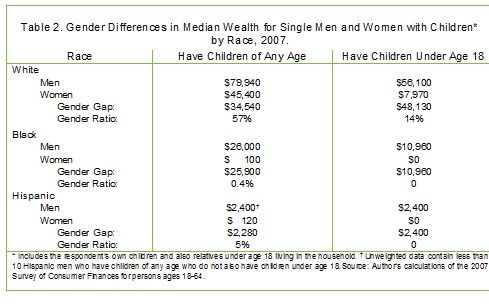
Source: http://www.cunapfi.org/download/198_Women_of_Color_Wealth_Future_Spring_2010.pdf
Which brings us to the wealth gap for women.
The gender wealth gap is based on a woman’s total wealth, or net worth. A much more complex measure with many more variables, it refers to the total value of one’s private assets minus debts. Typical types of assets include money in checking accounts, stocks or bonds, real estate, and businesses owned. Typical types of debts include home mortgages, credit card debt, and student loans.
The current economic crisis has revealed that even households with some wealth found that they did not have enough savings or wealth to make the investments necessary to get ahead. This is even more true for women. The gender wealth gap impacts not just current economic stability, but retirement security as well since women, frequently stuck in low paid part-time work receive lower social security and smaller pensions.
Most important, however, is the intergenerational transfer of wealth. The transfer of wealth through inheritance is one of the main reasons why racial and gender wealth gaps from policies long ago – – i.e., laws excluding women and people of color from owning property– have become entrenched.
The main problem in using the gender wealth gap as a measurement is that it is difficult to separate women’s wealth from male wealth inherited by a father or the wealth of the male spouse. When attempting to sort out wealth within marriages, studies of the gender wealth gap usually assume the wealth is divided equally between women and men which more thoughtful studies have shown not to be true. Using statistics from just single women and men who have never married shows a substantial wealth gap based on gender (women have only 6% -8% of men’s wealth). But this is also misleading since communities where both women and men have less wealth (i.e., working class communities and/or communities of color) marry at a much lower rates than middle class white communities where inheritance is a factor.

Source:http://www.cunapfi.org/download/198_Women_of_Color_Wealth_Future_Spring_2010.pdf
Sixty-five percent of all wealth that women continue to rely on is obtained indirectly from their spouses through marriage and inheritance from their fathers, rather than through their own wages . This keeps women dependent on men, through the system of unpaid labor in the family combined with underpaid labor in the marketplace, and reinforces women’s continued oppression under the patriarchal mode of production.
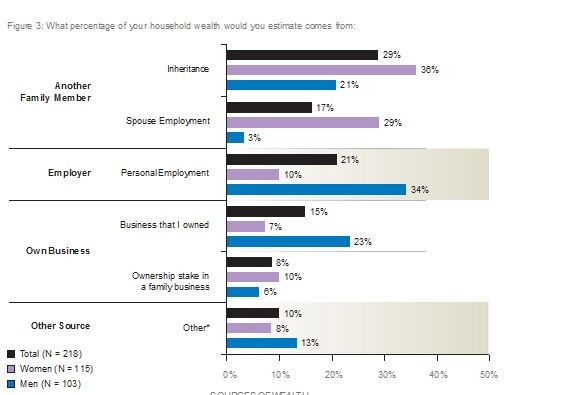
Source:http://www.genspring.com/documents/RESEARCH-Wealth_Alignment_Study_Summary_of_Key_Findings-20130208-GENSPRING.pdf
Radical feminism vs. socialist feminism.
Feminists and socialist feminists have held different views on the relationship between the patriarchal family unit and capitalism. Some women see the patriarchal family as a separate mode of production that existed before capitalism and that capitalism and class contradictions cannot be fully dealt with until patriarchy is eliminated. In this model, women’s struggles center around reproductive rights, ending patriarchal dominance in all its forms such as wife beating, rape, control of women’s bodies and reproductive functions. This form of oppression exists at all class levels and is seen as the primary form of women’s oppression.
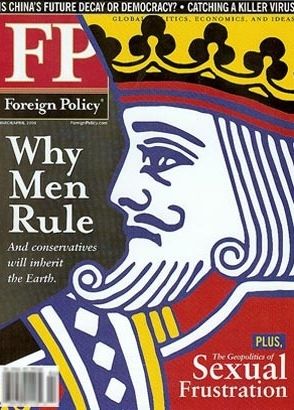
Other women see the patriarchal forms of oppression as still existing but as a substantially modified older mode of production that has been increasingly subsumed under capitalism. In fact marriage relations and the functions of the household have increasingly been transferred to the market society in the form of private commodities (healthcare, education, cooking and cleaning, child and elder care, etc.) Those who hold this position see capitalism as using women’s unpaid labor to extract extra profit indirectly from workers through the vestiges of patriarchy. They believe it can be dealt with by bringing women’s unpaid labor under the capitalist mode of production by paying wages for housework or providing families with a basic wage and then dealing with it like any other class struggle that the working class faces.
Two problems with this approach.
Women’s traditional service functions, as commodities in the market place, are regulated by the public sector or have simply been transferred to the public sector in social welfare states. In most cases these jobs are still performed by women and, since they have historically been associated with “women’s work” or the “free” labor in the home, then tend to pay less than traditional “male” jobs. While this has been somewhat mitigated by organizing unions in the public sphere, the financial downturn has been used as an excuse to attack these unions and return women to a lower paid more vulnerable position. Moreover, since women are still considered the primary service providers in the home, women are still the major recipients of these public services. Again, as these public services are cut, under the name of austerity, it is women who bear the brunt of the financial downturn.
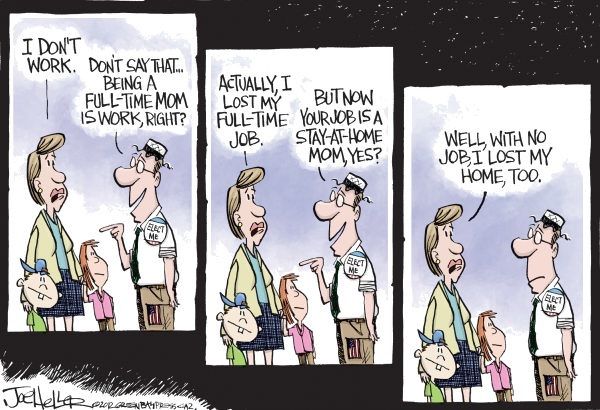
But it is not just a question of the current economic crisis. The social welfare reforms and the social safety net that we have fought for can be eliminated at any time when workers no longer serve the needs of capitalism. As capitalists have moved jobs abroad they no longer wish to pay for reproducing labor power that they no longer feel they need. Since women are still the main workers in the reproductive sphere, the elimination of the public social service sector falls particularly hard on women both as workers and consumers.
The second problem with this approach is that it leaves the patriarchal family unit intact and does not deal with the dynamics of dominance and submission between men and women. Wife beating and rape cross all class lines, as do certain structural advantages to males which are built into most societies such special real estate tax advantages which benefit primarily men and other tax benefits for married over single persons, etc..
Some have wondered if gender differences in wealth are really that important since whether we agree with it or not, most women supplement their wealth through marriage and the traditional family unit. In fact, women now spend more of their adult years single than married. About half of all households are headed by single women (defined as never married, widowed, or divorced) About half of all marriages end in divorce and men and women are marrying at later ages, leaving women with more years in which they are self-supporting. Given the current trends in rates of divorce, the increasing number of single parents, and rising ages at first marriage, the wealth gap for women is of considerable significance.
Even as the patriarchal family starts to crumble under capitalism, the capitalist market continues to push the ideology of “individual responsibility” to shore up the traditional social structure of marriage in the private sphere to avoid assuming the cost and responsibilities of child-rearing and welfare concerns in the public sphere. One wonders if the recent rapid embrace of gay marriage, especially by Republicans, is not just another attempt to shore up the failing institution of marriage.
So women are left without any adequate private family solution (if it ever was one) and, are faced simultaneously with the shredding of the social safety net as global capitalists leave any alliance they may have had with individual nation states in pursuit of ever greater cheap global labor and profits.
The interaction of the gender wealth gap and the racial/class wealth gap. There is no easy way to clearly differentiate between sex, class and race privilege since they have been inextricably intertwined in the U.S. The mainstream wage gap analysis, unlike the wealth gap analysis, does not take into account the depth & dynamics of institutionalized racism and sexism over time and it also does not describe the wealth gender gap within communities of color.
Most people of color and immigrants , like women, have had limited opportunity to accumulate wealth. For the better part of our history, both people of color as slaves and married women were considered property and could not own property, the major source of wealth accumulation. Men’s wages in communities of color are significantly lower and, in spite of the civil rights movement, most men of color are still in the working class with very little wealth accumulation. Moreover, the jobs areas most populated by minorities and immigrants (domestic labor, agriculture), are not included under the Fair Wage Act in the United States.
Women in communities of color generally have significantly lower wealth and are less likely to marry and to remain married when the men in their community do not have substantially more wealth than the women and there is less inheritance to consider. Institutionalized sexism and racism have kept both women and men of color out of unions, out of political power, out of well paying white male segregated jobs. Women of color form the vast majority of workers in part-time informal work and the low paid service sector.
When we separate the gender wage gap by race, white women make 87% for every dollar a white man makes, Latinas make 59% of a man’s dollar and black woman make 61% of every dollar a man makes. This is bad enough, but when using the wealth gap, black and Latina women, have a negative wealth accumulation: that’s less than 0% or, depending on the study, maybe a fraction of 1% compared to all men. The wealth gap for single women, of all races, especially those who have never been married or single women with children is similar. Meanwhile white middle class married women have 67% wealth accumulation, compared to all men. While, this still is not great, we cannot ignore this internal difference in the women’s movement.

Comparing difference in the wealth gap for white middle class women and women of color is not a divide and conquer technique or to “guilt trip” white middle class women, but to show how our particular circumstances effect policy and feminist practice. Feminists who see Patriarchy as the main enemy, obliterate the differences between women of color and white women. If one believes that cross class patriarchal issues of male dominance are the primary concern, any emphasis on related issues of race or class discrimination are secondary or “added on” so it is difficult to assess the cumulative effect.
On a more practical basis, rights such as abortion and contraception might be sufficient gains for white middle class married women as they assume that when the time comes and they choose to have a child, their career path will not be greatly interrupted because they can pay for childcare or hire someone, usually another woman of color or an immigrant, to take on those aspects of unpaid labor that limit their choices. This division was made clear by the failure of the predominantly white middle class women’s movement to organize a fight back against the Hyde amendment which denies poor women abortions since the right to abortion for women who could afford one had already been established.
So short of a socialist revolution tomorrow, what are some policies that can seriously attack the underlying problem instead of just accepting the idea that all we can work for is upward mobility for a few women? Some of the following suggestions will not seem like women’s issues, but if we put them on the agenda, we will be able to attack institutionalized racism and sexism at the same time and make serious dents in all women’s oppression.
Proposed Solutions:
1. End tax breaks for marriages. Develop civil unions (a concept already in use)for any two or more people who wish to make an economic contract with the state for raising children (i.e., an aunt and a niece raising the niece’s children, three friends, etc.). There should be no presumption that they are having a sexual relationship or live in the same residence- and give them all the rights of married people and family subsistence pay.
2. Limit on amount people can inherit. (Warren Buffett suggests a 100% inheritance tax). The money could go to providing social services for the next generation.
3. Provide free universal daycare from age two on. Research from the UC Berkeley Labor Center on California’s childcare support system showed that a lack of access or ability to afford childcare is one of the most significant barriers to getting a job and staying in it. A continuous work history is correlated with higher pay and better benefits. One study estimated that if the government fully funded childcare programs, mother’s overall employment would jump 10 percent.
4. Pass family leave policies. Nearly three-quarters of children have both parents or their only parent in the workforce. This isn’t just an inconvenience, however. It has real financial impacts on working women. A woman who gets thirty or more days paid family leave is over 50 percent more likely than those who get nothing at all to see her wages increases the year after her child’s birth.
5. Take a note from the Venezuela handbook and develop local communal councils for economic planning for local social services where women are the major decision makers. If the government won’t support the initiatives, develop local credit unions and other grassroots economic initiatives (local childcare cooperatives and “helping hand” groups to give women control over their own economics).
6. Raise the minimum wage. According to the National Women’s Law Center, about two-thirds of all workers making the minimum wage are women (and I suspect women of color), and they’re also about two-thirds of those in tipped occupations that often pay a base rate far below that. Raising that wage could mean a raise for 28 million workers. Sometimes a quantitative difference is so great it can create a qualitative difference and transformative change.
7. Encourage unionization. Increased unionization rates are correlated with a much smaller wage gap. The gap stands at 79.9 percent among employees who aren’t represented by a union, but it’s a much better 87.8 percent for those who are.
8. End occupational segregation. Women have yet to really break into the ranks of blue collar manufacturing jobs and are still clumped in service sector jobs. Even when the job skills required are comparable, at the low end of skill level, male-dominated fields pay nearly $150 more a week. Things are even worse at the high-skill level where women’s pay is a whopping $471 less a week.
References
“More Women Are Bringing Home the Bacon …” by Bruce Watson May 29th 2013 3:30 PM
Updated May 29th 2013 4:12 PM (Daily Finance)
“Lifting as We Climb Women of Color, Wealth, and America’s Future”
http://www.cunapfi.org/download/198_Women_of_Color_Wealth_Future_Spring_2010.pdf
“Shortchanged: Women and the wealth gap” by Alison Perlberg on Monday, April 4, 2011 – 1:52am
Inheritance and spousal wealth: http://www.genspring.com/docum…
